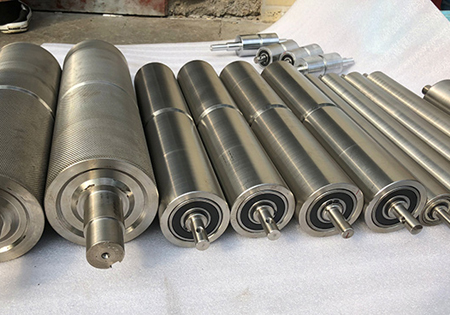Mastering Manual Machining of Industrial Rollers: Techniques and Best Practices
Industrial rollers are essential components in a wide range of machinery and equipment, playing a critical role in processes such as material handling, printing, and textile manufacturing. While CNC machining has become increasingly prevalent, manual machining remains a vital skill, particularly when it comes to custom or repair work on industrial rollers. Mastering the art of manual machining requires a deep understanding of techniques, tools, and best practices to achieve precision and durability. In this blog, we'll explore the key aspects of manual machining for industrial rollers, offering insights and tips for machinists and maintenance teams in the UK.
Understanding the Role of Industrial Rollers
Industrial rollers are cylindrical components used to convey, press, or support materials within various machines. They can be found in applications ranging from conveyor systems to printing presses, where they help move products along a production line or apply pressure to materials. The precision and quality of these rollers are critical to the efficiency and effectiveness of the machinery they serve.
Given their continuous use and exposure to wear, industrial rollers often require machining to restore their surface, adjust dimensions, or repair damage. Manual machining is a hands-on process that allows for precise adjustments and custom work, making it ideal for one-off projects or when high flexibility is needed.
Key Techniques in Manual Machining of Industrial Rollers
Manual machining involves various techniques that must be mastered to ensure the production of high-quality rollers. Here are some of the most important:
-
Turning:
- Lathe turning is one of the primary techniques used in the manual machining of industrial rollers. It involves rotating the roller while a cutting tool is applied to its surface to achieve the desired diameter and finish. Precision turning is essential for ensuring that the roller's surface is smooth and evenly cylindrical.
- Taper turning can also be performed to create rollers with a tapered shape, which might be required for specific applications.
-
Facing:
- Facing is the process of machining the ends of the roller to ensure they are flat and perpendicular to the roller’s axis. This step is crucial for ensuring that the roller can be properly aligned and mounted within machinery. The facing process also helps eliminate any surface irregularities that could affect the roller's performance.
-
Grooving and Knurling:
- Grooving involves cutting grooves or channels into the roller’s surface. These features can be important for rollers used in applications where traction or specific material handling properties are required.
- Knurling is the process of creating a textured pattern on the roller’s surface. This is often used to improve grip or traction on the materials passing over the roller. Both grooving and knurling require careful control to achieve consistent patterns and depths.
-
Drilling and Boring:
- Drilling may be required to create holes or cavities in the roller, such as for mounting purposes or to reduce weight.
- Boring is a similar process but is used to enlarge an existing hole or achieve a precise internal diameter. Both techniques require accurate alignment and steady hand control to ensure the holes are perfectly centred and to the correct dimensions.
-
Surface Finishing:
- Achieving a high-quality surface finish is crucial for the performance of industrial rollers. Manual polishing and lapping can be employed to refine the roller’s surface, reducing friction and wear during operation. The choice of finishing technique depends on the material of the roller and the required surface characteristics.
Best Practices for Manual Machining of Industrial Rollers
Achieving excellence in manual machining requires more than just technical skill; it also demands adherence to best practices that ensure precision, safety, and efficiency. Here are some of the key best practices to follow:
-
Tool Selection and Maintenance:
- Selecting the right tools for each machining operation is essential for achieving the desired results. Ensure that cutting tools are sharp and well-maintained, as dull tools can lead to poor surface finishes and inaccurate dimensions.
- Regularly inspect and replace worn or damaged tools to maintain the quality of your work. For instance, carbide-tipped tools are commonly used for their durability and ability to maintain sharpness, especially when machining hard materials.
-
Accurate Setup and Alignment:
- Proper setup and alignment of the roller in the lathe or other machining equipment are critical for precision. Ensure that the roller is securely mounted and that its axis is perfectly aligned with the machine's spindle. This minimises runout and ensures even machining across the entire surface of the roller.
- Use dial indicators or other precision measuring tools to verify alignment before starting the machining process.
-
Controlled Cutting Parameters:
- Adjust the cutting speed, feed rate, and depth of cut according to the material of the roller and the type of machining operation. For example, softer materials like aluminium may require higher cutting speeds but lower feed rates to avoid damaging the surface.
- Take light cuts when approaching the final dimensions to ensure a smooth finish and to prevent overshooting the target measurements.
-
Regular Measurements and Monitoring:
- Continuously monitor the progress of the machining operation by taking regular measurements with micrometres, calipers, or other precision instruments. This helps detect any deviations early and allows for corrective action before the final dimensions are reached.
- Record measurements throughout the process to track consistency and ensure that the roller meets the required specifications.
-
Attention to Safety:
- Safety is paramount in manual machining. Always wear appropriate personal protective equipment (PPE), such as safety glasses, gloves, and hearing protection.
- Keep the work area clean and free of obstructions, and ensure that all machine guards are in place and functioning correctly.
- Be mindful of the risks associated with manual machining, such as sharp edges, hot surfaces, and flying debris, and take precautions to mitigate these risks.
-
Surface Treatment and Coating:
- Depending on the application, the roller may require additional surface treatments or coatings to enhance its performance. Common treatments include hardening, plating, or applying a wear-resistant coating. These treatments can improve the roller's durability, reduce friction, and protect against corrosion.
- When applying surface treatments, ensure that they are evenly distributed and properly cured to maintain the roller's precision and performance.
Conclusion
Manual machining of industrial rollers is a skilled craft that requires a deep understanding of machining techniques, careful attention to detail, and adherence to best practices. While CNC technology has revolutionised the machining industry, the ability to manually machine rollers remains invaluable, especially for custom jobs, repairs, and one-off projects.
For machinists and maintenance teams in the UK, mastering these manual machining techniques ensures that industrial rollers are machined to the highest standards of precision and quality. By following the guidelines outlined in this blog, you can achieve optimal results, whether you’re manufacturing new rollers or refurbishing existing ones.
In a world where precision and reliability are paramount, the art of manual machining continues to play a crucial role in keeping industries moving forward. Whether you’re in a small workshop or a large-scale manufacturing facility, honing your manual machining skills will ensure that you remain a vital part of the industrial landscape. For specialist advice and a no-obligation quotation, call IME on 02085996570 or email sales@imegroup.co.uk.

